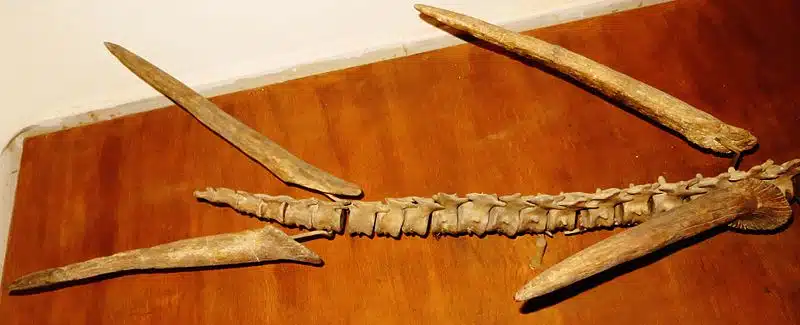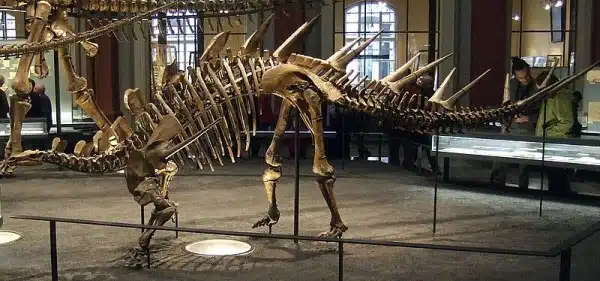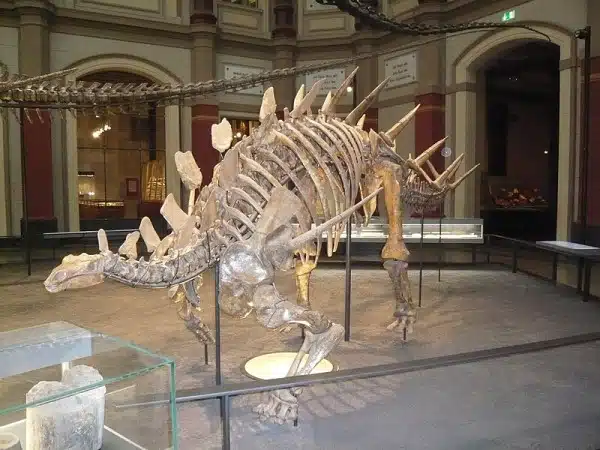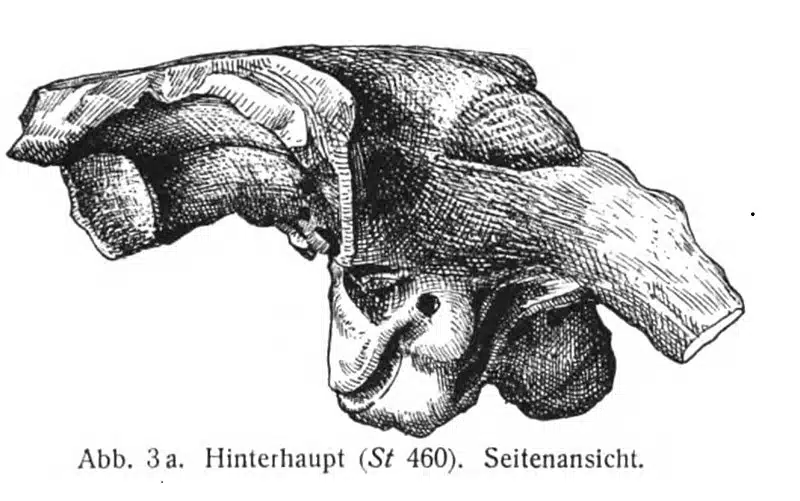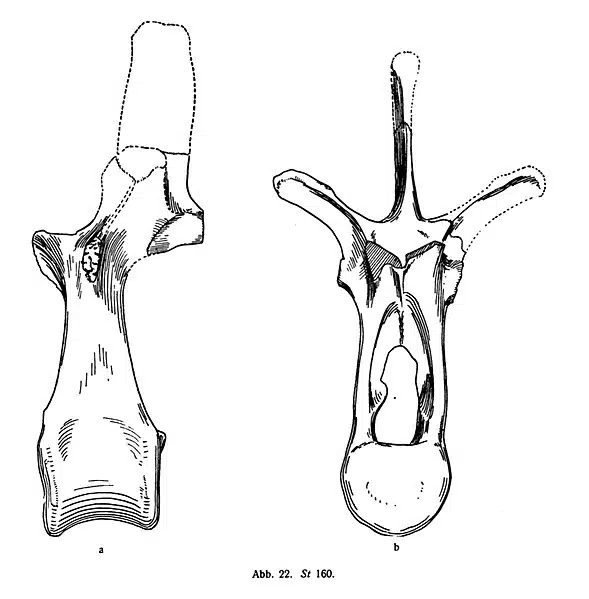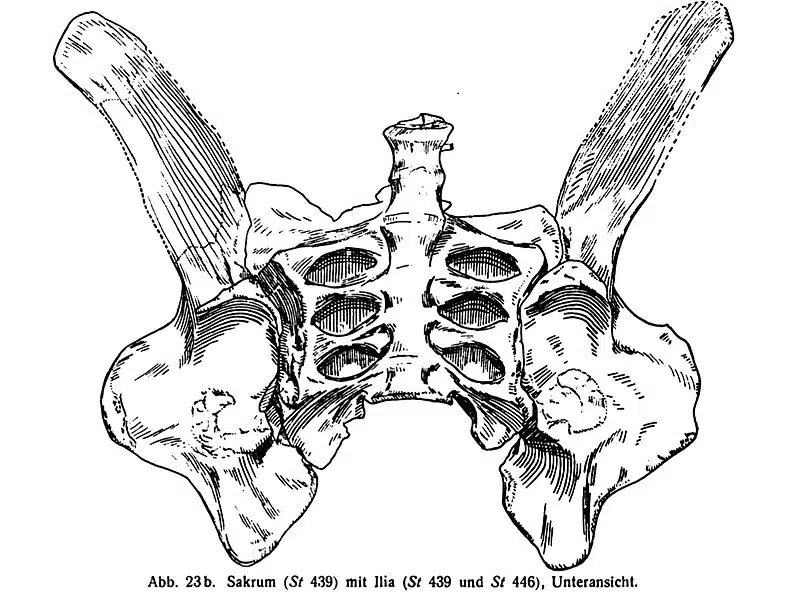Kentrosaurus was a herbivore dinosaur from the Stegosauria group that lived more than 150 million years ago. Its distinctive spikes and plates, large for a Stegosaur, made it stand out even among other spiky dino’s.
Kentrosaurus Key Facts
| Keyword | Fact |
|---|---|
| Pronunciation | ken-TROH-sore-us |
| Meaning of name | Sharp point/Spiky lizard |
| Group | Stegosauria |
| Type Species | Kentrosaurus aethiopicus |
| Diet | Herbivore |
| When it Lived | 163.5 to 150.8 MYA |
| Period | Late Jurassic |
| Epoch | Oxfordian to the top of the Late/Upper Kimmeridgian |
| Length | 13.0 to 15.0 feet |
| Height | 5.9 feet |
| Weight | 1,500 to 3,500 lbs |
| Mobility | Moved on all four |
| First Discovery | 1909 by German Tendaguru Expedition |
| Location of first find | Tendaguru Formation, Tanzania |
| First Described by | 1915 by Edwin Hennig |
| Holotype | MB.R.4800.1 through MB.R.4800.37 |
Kentrosaurus Taxonomy and Timeline
Kentrosaurus name, meaning “sharp point” or “spiky lizard,” is really fitting, as it conjurs up an image of a dinosaur bristling with spikes and plates. The name comes from the Greek words ‘kentron’, meaning spike, point or thorn, and ‘sauros,’ meaning lizard/dinosaur. While Stegosaurs are known for their various spikes and plates, Kentrosaurus had some really awesom spikes. Almost like a cactus, it had a number of impressive spikes, with a couple of really long ones on its shoulders.
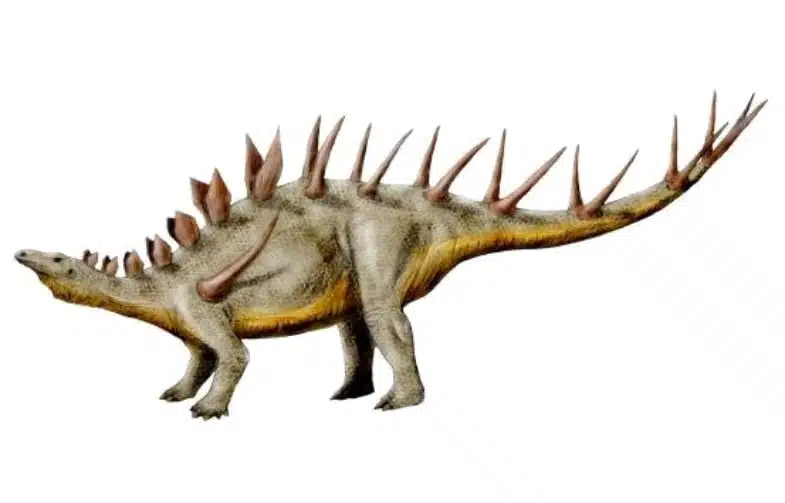
Belonging to the Stegosauria group, Kentrosaurus is part of the Stegosaurid family. Its type species, Kentrosaurus aethiopicus, is the only member of the genus and stands as a testament to its unique evolutionary path within the dinosaur kingdom.
This spiky inhabitant of the Late Jurassic Period thrived during the Oxfordian to Late Kimmeridgian Epochs, just a little over 150 million years ago. This timeline places it in a world that was teeming with diverse life forms, both on land and in the seas.
Discovery & Fossil Evidence
The first fossilized remains of Kentrosaurus were discovered in 1909, by the German Tendaguru Expedition’. The expedition, led by Werner Janensch, unearthed the fossils in Tanzania, and later it was Janensch who first recognized them as belonging to a stegosaur. The formal description of the fossils was penned by German paleontologist Edwin Hennig in 1915, marking the official introduction of this herbivorous dinosaur to the scientific community. While the expedition didn’t uncover any complete individuals, they did find some material in association. This included a nearly complete tail, hip, several dorsal vertebrae, and some limb elements of one individual.
- Kentrosaurus aethiopicus
- Endocasts of the sacral ganglion and brain at Museum of Paleontology of Tübingen
- Thagomizer at the Museum of Palaeontology of Tübingen
- Fossil Kentrosaurus aethiopicus in Museum für Naturkunde Berlin.
- Skeleton of a Kentrosaurus in the Natural History Museum Berlin
- Braincase of Kentrosaurus in lateral view.
- Illustration of a dorsal (back) vertebra of Kentrosaurus in lateral and anterior views.
- Sacrum of Kentrosaurus in ventral view.
The excavation sites span four quarries in the Middle Saurian Beds and one in the Upper Saurian Beds. Over the course of four field seasons, the expedition unearthed over 1,200 bones attributed to approximately 50 Kentrosaurus individuals. However, the ravages of the Second World War took a heavy toll and destroyed many of these priceless individuals.
Today, the Museum für Naturkunde Berlin is the custodian of the majority of the remaining material, housing reamins from roughly 350 specimens. Additionally, the museum of the Institute for Geosciences at the University of Tübingen boasts a composite mount of Kentrosaurus, with about half of it consisting of original bones. These remnants, though fragmented, offer a tantalizing glimpse into the life and times of this remarkable dinosaur.
Kentrosaurus Size and Description

Kentrosaurus was a smaller member among the stegosaurs. It possessed a small head, a long and muscular neck, and a horizontal tail that was both long and robust. The forelimbs were short yet powerfully built, contrasting with the erect, pillar-like hindlimbs. A defining characteristic of Kentrosaurus, as with other Stegosaurids, was the array of plates and spikes that adorned the top mid-line of its body, running along both sides. These features not only contributed to its distinctive appearance but also played a role in its survival strategies.
Size and Weight of Type Species
Kentrosaurus aethiopicus was relatively modest in size for a stegosaur, measuring approximately 13.0 to 15.0 feet in length and weighing between 1,500 to 3,500 pounds. However, some specimens suggest the existence of larger individuals, comparable in certain aspects to some Stegosaurus specimens. Notably, the development of the olecranon process in the forearms of these larger specimens indicates a potential for greater size within the species.
The Dinosaur in Detail
The long tail resulted in a center of mass that was unusually far back for a quadrupedal animal, resting just in front of the hip. This is a position typically seen in bipedal dinosaurs. However, the straight femora of Kentrosaurus, as opposed to the angled femora of typical bipeds, indicated a straight and vertical limb position. Consequently, while the hindlimbs were powered by massive thigh muscles attached to a long ilium, they did not support the animal alone. The robust forelimbs bore 10 to 15% of the body weight. The powerful hind limbs even enabled Kentrosaurus to achieve a tripod stance on its hindlegs and tail like modern kangaroos.
The armor that covered this dinosaur was distinctive, even among fellow stegosaurs. Interestingly, the osteoderms (bony structures in the skin) did not significantly alter the center of mass in Kentrosaurus or Stegosaurus, allowing these armored dinosaurs to remain mobile. This armor consisted of flat plates that gradually transitioned into sharp spikes towards the tail. They were paired and arranged symmetrically in two rows down its back.
Only one half of the bottom jaw is known from this dinosaur. The teeth found there are similar to other stegosaurs and wear patterns show that they ground their food using their cheek teeth like many herbivores. Based on these similarities, it is possible that the tip of the mouth was covered in a beak.
Interesting Points about Kentrosaurus
- Kentrosaurus’s spikes could have been used for defense or display.
- It was one of the few dinosaurs discovered in Africa from the Late Jurassic Period.
- The unique arrangement of plates and spikes is a distinctive feature.
- Its fossils were first discovered by a German expedition in Tanzania.
- Its exact size and weight remains a subject of scientific curiosity.
The Kentrosaurus in its Natural Habitat
This herbivore thrived in a world that was both lush and very diverse. The Late Jurassic Period was characterized by a warm climate, with abundant vegetation providing ample food. Its diet likely consisted of low-lying plants, which it could easily reach with its long neck. It is possible that its ability to rear up onto its hind legs would have given it a chance to feed on the lower branches of trees.
Moving on all four legs, Kentrosaurus navigated its environment with a certain grace despite its heavy armor. While not a predator, its spikes would have made it a formidable opponent. Living in a world where giant Sauropods and fierce theropods roamed, these physical features were not just for show; they were crucial for survival.
In terms of social behavior, it’s not definitively known whether Kentrosaurus was a solitary creature or lived in herds but its physical attributes suggest it could have held its own in either scenario. Its impact on the landscape and ecosystem of its time, while not fully understood, would have been significant given its size and dietary habits.
Contemporary Dinosaurs
In this green, leafy landscape of the Late Jurassic Period, this spiky-backed herbivore roamed with a sense of cautious curiosity. Its life was a constant dance of survival, intertwined with the lives of its contemporary African dinosaurs.
Imagine its armor of spikes and plates as it ambled through the ferns and cycads, always on alert. It was smaller than the Janenschia, a fellow herbivore, which lumbered through the same territory. Their interactions were likely those of peaceful coexistence, perhaps grazing side by side like elephants and zebras on a modern savanna. However, competition for the juiciest leaves and most nutritious plants could not be ruled out as each sought to sustain its massive frame.
But life wasn’t all about peaceful grazing. Danger lurked in the form of the formidable Torvosaurus, a predator that towered over the Kentrosaurus. This carnivorous giant was larger and more menacing and might have seen the herbivore as a potential meal. One can picture the heart-pounding chases, with the Kentrosaurus relying on its spiky defenses and agility to escape the deadly jaws of the Torvosaurus. It was a classic predator-prey drama that played out under the shadow of ancient trees.
Then there was the Elaphrosaurus, roughly the same size as the Kentrosaurus but a carnivore. Their paths might have crossed, leading to tense standoffs or swift retreats. The Kentrosaurus would have been wary of these encounters despite its armor, always mindful of the delicate balance between being a hunter and the hunted.
In this prehistoric world, the Kentrosaurus was not just a creature trying to survive. Rather, it was a central figure in a complex ecosystem where each competitive or predatory interaction painted a vivid picture of life millions of years ago.
Frequently Asked Questions
It is Greek in origin and means “sharp point” or “spiky lizard,” a reference to its distinctive spikes.
It lived during the Late Jurassic Period, around 163.5 to 150.8 million years ago.
It was an herbivore, that likely fed on low-lying plants and perhaps the lower branches of trees.
It was first discovered in the Tendaguru Formation in Tanzania.
Its double row of plates and spikes along its spine and tail are its most notable features.
It moved on all four legs, likely at a slow but steady pace.
Sources
The information in this article is based on various sources, drawing on scientific research, fossil evidence, and expert analysis. The aim is to provide a comprehensive and accurate overview of the Kentrosaurus. However, please be aware that our understanding of dinosaurs and their world is constantly evolving as new discoveries are made.
Article last fact-checked: Joey Arboleda, 04-06-2025
Featured Image Credit: Nobu Tamura, CC BY-SA 3.0 https://creativecommons.org/licenses/by-sa/3.0, via Wikimedia Commons



